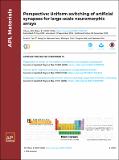Perspective: Uniform switching of artificial synapses for large-scale neuromorphic arrays
Author(s)
Tan, Scott H. (Scott Howard); Lin, Peng; Yeon, Hanwool; Choi, Shinhyun; Park, Yongmo; Kim, Jeehwan; ... Show more Show less
DownloadPublished version (5.838Mb)
Publisher with Creative Commons License
Publisher with Creative Commons License
Creative Commons Attribution
Terms of use
Metadata
Show full item recordAbstract
Resistive random-Access memories are promising analog synaptic devices for efficient bio-inspired neuromorphic computing arrays. Here we first describe working principles for phase-change random-Access memory, oxide random-Access memory, and conductive-bridging random-Access memory for artificial synapses. These devices could allow for dense and efficient storage of analog synapse connections between CMOS neuron circuits. We also discuss challenges and opportunities for analog synaptic devices toward the goal of realizing passive neuromorphic computing arrays. Finally, we focus on reducing spatial and temporal variations, which is critical to experimentally realize powerful and efficient neuromorphic computing systems.
Date issued
2018-12Department
Massachusetts Institute of Technology. Department of Mechanical Engineering; Massachusetts Institute of Technology. Research Laboratory of Electronics; Massachusetts Institute of Technology. Department of Materials Science and EngineeringJournal
APL Materials
Publisher
AIP Publishing
Citation
Tan, Scott H. et al., "Perspective: Uniform switching of artificial synapses for large-scale neuromorphic arrays." APL Materials 6, 12 (December 2018): 120901 ©2018 Author(s)
Version: Final published version
ISSN
2166-532X